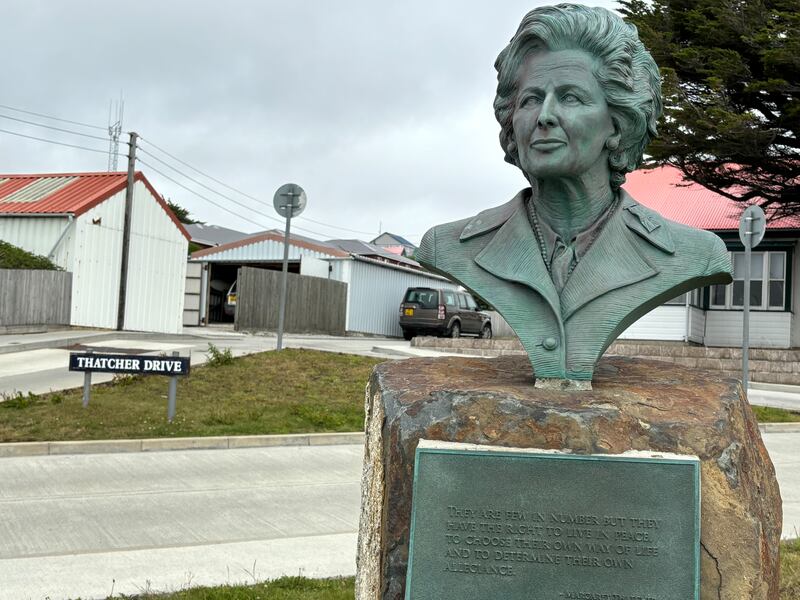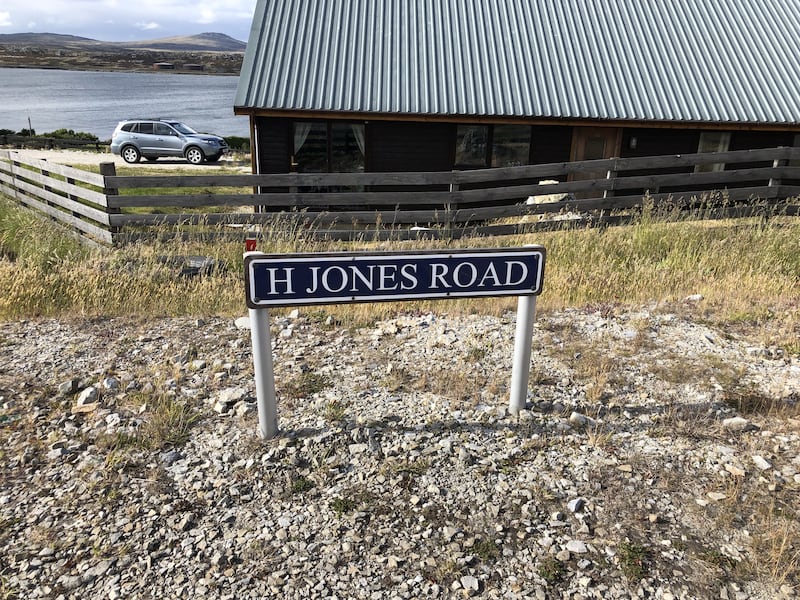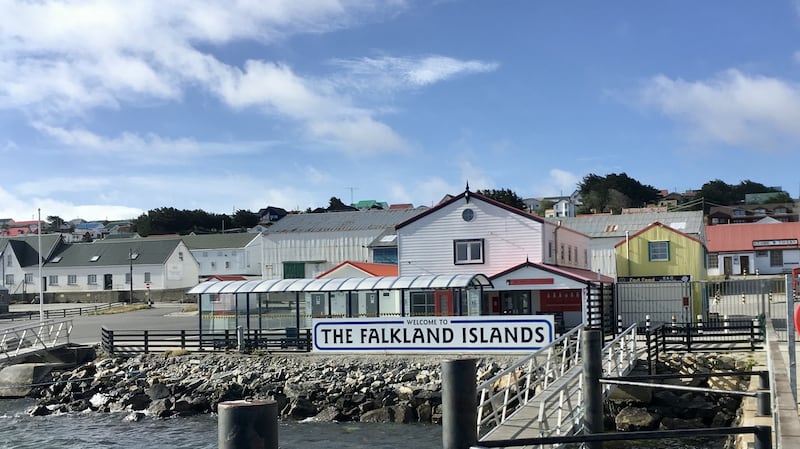The first impression as you drive away from Mount Pleasant Airport is the sheer barrenness of the place – like the English moors, beautiful in a bleak kind of way that gets old very quickly – and a smell of peat that will remain in your nostrils for as long as you’re here. As you take the winding road towards the capital of Stanley, the aircraft that brought you here will pass overhead on its way back to Punto Arenas in southern Chile, and you know that it won’t be back for a week, confirming the sense that you are a very long way from home.
As the road wends its way through the flat, featureless countryside, it’s difficult not to think about the tragic absurdity that, in 1982, Britain and Argentina went to war over this dull crumb on the map of the south Atlantic and more than 900 people died. The journalist and military historian Max Hastings described the Falklands or Malvinas war as a point of pride versus a point of principle over a series of islands that have always been wanted more than loved. The Argentinian writer Jose Luis Borges characterised it more memorably as “two bald men fighting over a comb”.
As a child I was fascinated by the war, initially because of the threat it posed to that summer’s World Cup. In our house we read British tabloid newspapers, and I was fixated on their graphics explaining such things as the relative strengths of Argentina’s Mirage fighter planes versus Britain’s Harriers. Years later I chose it as my special study topic for my Leaving Cert history exam. Since then I must have read dozens of books on the subject, and the number one item on my bucket list had always been to hike the fields and mountains where this most bizarre war played out.
Actually it’s more accurate to describe it as a conflict, since war was never formally declared – even as Margaret Thatcher dispatched 25,000 personnel in a fleet of 127 ships a grand distance of 8,000 miles to take back a relic of empire that most British people didn’t know existed. Ken Lukoviak, a member of the second battalion of the Parachute Regiment, whose A Soldier’s Song is one of the most shocking memoirs of the war, recalled his father telling him that Argentina had invaded the Falklands and wondering how they got all the way up to Scotland without anyone noticing.

Stanley – where two-thirds of the islands’ 3,500 inhabitants live – is called a city, but in Ireland it would be considered a village, and a small one at that. The houses are an odd mix of slate-grey brick terraces, which could have been transplanted there from any English seaside town, and prefabricated buildings with varicoloured, tin roofs. The locals are friendly and welcoming and British in a way that might lead people who actually live in Britain to say, “Steady on, old chap”. There is a profusion of union flag bunting, photographs of King Charles and the late Queen Elizabeth II, red post boxes and a bust of Margaret Thatcher that stares out at the ice-cold ocean from a road named Margaret Thatcher Drive.
Most of those who remember the brief Argentinian occupation are old now, but there are echoes of the war everywhere you walk. Fifty metres up the road from the 1982 Liberation Memorial – an obelisk with the figure of Britannia on top – a sign in a window reads: “To the Argentine nation and its people. You will be welcome in our country when you drop your sovereignty claim and recognise our right to self-determination.”
The names of the roads recall prominent figures from the conflict. There’s Sandy Woodward Road, named after the royal navy officer who commanded Britain’s taskforce; H Jones Road, named after the most famous casualty of the war; and Rick Jolly Way, named after the royal navy medical officer who was decorated by both Britain and Argentina for distinguished conduct.

War tourism isn’t really a thing here. The islands are too remote from Britain to become another Normandy or Flanders. Most visitors are Americans disgorged from the cruise ships that round Cape Horn on the way from Buenos Aires to Santiago and are far more interested in visiting the magnificent penguin colonies than the sites of some peculiar, half-century-old, colonial flashpoint.
But many former British and Argentinian service personnel do return – usually to lay wreaths at one of the many memorials or even the exact point where comrades died. Widows and children of those killed also visit to tour the sites, many of them driven by Tony Heathman, a fourth-generation islander who has been operating battlefield tours here for four decades. Most of the war was fought in East Falkland – the northern part of one of the two main islands – and it’s possible to visit all of the points of military interest, as we did, in two 10-hour days.
Our first stop is the settlement of Darwin, a 40-minute drive west of Stanley. It was here, in Port Pleasant, that the logistics ship, the Sir Galahad, along with the Sir Tristam, was bombed by Argentinian Skyhawks. Most of the 56 men killed were Welsh Guards, and there is a monument dedicated to them close to the beach from where the evacuees, some of them horribly burned, watched the two ships go up in flames. At the foot of the monument is a metal box containing letters from friends and loved ones to those who died.
Not far from here is the Argentine Military Cemetery. In the immediate aftermath of the war, Argentina’s ruling military junta refused Britain’s offer to repatriate the bodies of its dead, many of whom were teenage conscripts. They argued that because the islands – which they refer to as Las Malvinas – belonged to them, they were already buried in Argentinian soil. So the British consolidated all of the temporary graves into a single location.
A visit to the cemetery is a deeply affecting experience. A sharp wind whips through it and, in the silence, you can hear the sound of rosary beads clinking off some of the 236 white crosses that mark the bodies of the Argentinian dead. Some of the crosses are swathed in blue-and-white-striped football jerseys, a reminder that many of those killed were young football fans looking forward – just as I was – to that summer’s World Cup.
As we leave, I ask Heathman what was Argentina’s post-invasion plan for the islands. Were they going to move the natives out and give their homes and farms to Argentinian settlers?
“No, they thought they were liberating us,” he says in his English West Country accent. “I remember an Argentine soldier knocked on my door – I can still see him standing there with his gun – and he said, ‘You don’t have to be frightened any more.’ I said, ‘Frightened of what?’ and he said, ‘British oppression.’ This is what they’d been taught.”
The Battle of Goose Green, one of the fiercest and most controversial in the 74-day war, was fought close to here. Goose Green, a small development of houses and sheep-shearing sheds, is on the narrow isthmus that separates East Falkland from Lafonia, the southern part of the island. It was of no real strategic value but was ordered to give the British an early win to settle nerves back in Westminster. It was here, amid burning gorse, that Lieut Col “H” Jones, commanding officer of the second battalion of the Parachute Regiment, was shot dead while storming a piece of raised ground that legend has turned into “Darwin Hill”. There is a memorial to him at the point where he died – bravely to some, foolhardily to others – and a cross to mark the spot from where the bullet that killed him was fired.
Jones, who was awarded the Victoria Cross posthumously, is buried an hour’s drive northwest of here in Blue Beach War Cemetery, overlooking San Carlos Bay, where British forces first came ashore. In the sand here lie the remnants of the grip mats that were used in the amphibious landing.

From San Carlos, the British marched – or “tabbed” – 100km across East Falkland to liberate Stanley, engaging in fierce fighting, sometimes hand to hand, to take a series of mountains, all of which we climbed on the second day.
The most infamous of these battles was that for Mount Longdon, which the third battalion of the Parachute Regiment took from a numerically superior Argentinian force, dug in high on the mountain in a series of bunkers. Many of these remain intact, and inside you can still find the ephemera of war, including small, round tins that once contained the meat paste that was part of every Argentinian soldier’s ration pack.
[ Paul Howard on that most peculiar craft – writing, an act of daringOpens in new window ]
Like all of the other mountains conquered on the way to Stanley – Tumbledown, Harriet, Two Sisters, Kent – there is a steel cross at the summit, at the foot of which former comrades and loved ones have placed wreaths and other tributes. A large number of those on Longdon are for Corporal Stewart “Scouse” McLaughlin, whose ferocity is said to have turned the battle, but who was denied a posthumous Victoria Cross following a claim from an officer that his webbing pouch was found to contain sawn-off human ears and other unspecified Argentinian body parts.
It isn’t the only reason why Longdon feels like a black and dismal place to me rather than a scene of heroism and gallantry. Vincent Bramley, a platoon leader with 3 Para, claimed in his shocking account of the war, Excursion to Hell, that a number of Argentinian prisoners were executed here after they surrendered.
The summit, which also features a rusted Argentinian artillery gun, offers spectacular views of East Falkland, including the deep scars left in the ground from the 40-year job of landmine removal. The drive between the mountains is across rocky ground pocked with shell holes that only a 4x4 can negotiate. The journey yields other pieces of military bric-a-brac, like the twisted, skeletal remains of two bombed-out Argentinian helicopters, sangars containing more ration packs and rusted anti-personnel mines.
Tumbledown is one of the easiest of the mountains to ascend, but its name is well earned. It’s necessary to crouch as I reach the top to prevent the strong South Atlantic wind from sweeping me off. In a small hollow, sheltered from the wind, are the corroded remains of a peat-fired cooking stove. It’s easy to imagine young Argentinian conscripts eating soup here to try to stay warm in the sub-zero cold as they waited for the enemy to come and either shoot them or drive them from the mountain.
The last mountain taken, by a combination of royal marines and Welsh guards, was Sapper Hill, which looks down on Stanley. The British expected to have to fight for the capital street by street, but the Argentinian forces on the island surrendered against the express orders of Leopoldo Galtieri, Argentina’s president and head of the military junta that ruled the country.
A short detour off the road back to Stanley reveals memorials to the Atlantic Conveyor – a giant, bronze propeller – and HMS Glamorgan, two British ships that were taken out of the war by Exocet strikes, resulting in a total loss of 26 lives.
Then I return to the capital with its English pubs and its fish and chips and its white-picket-fence-encircled Government House, feeling dark and depressed by the things I’ve seen and the smell of peat that seems to have infiltrated my pores. Coming here is an itch scratched, an almost-lifelong curiosity satisfied. But it also confirms for me the stupid wastefulness of it all.
I go for a walk to clear my head. As I take in the incongruous sight of a Magellanic cormorant standing on top of a red London bus converted into a greasy spoon cafe, I put on my earphones and listen to a playlist of songs inspired by the war. If nothing else good came out of the conflict, it at least produced some great music, including Shipbuilding by Elvis Costello, Brothers in Arms by Dire Straits, Glad it’s all Over by Captain Sensible, Tango Atlantico by Joe Jackson, Island of No Return by Billy Bragg, Fields of Fire by Big Country, Marquis Cha Cha by The Fall and Get Your Filthy Hands Off My Desert by Pink Floyd.
But the song I keep returning to, as the memory of those white crosses, sheathed in Argentina football jerseys, stays lodged in my head, is Chris de Burgh’s Borderline and the simple truth of lyric: “These are only boys and I will never know how men can see the wisdom in a war.”


















